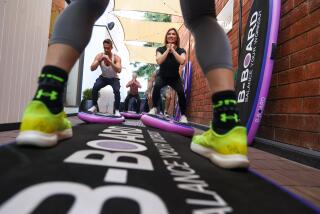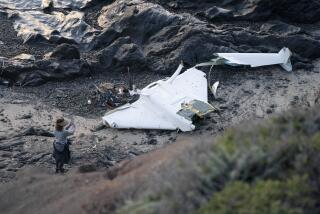Herman Bank dies at 96; engineer designed collapsible surfboard
As one of the Jet Propulsion Laboratory “rocket boys,” engineer Herman Bank had already helped launch the Space Age when wobbly surfboards strapped atop his station wagon in the early 1960s led him to another design frontier.
After securing his cargo alongside a Los Angeles freeway, Bank puzzled over how to make the era’s nearly 10-foot-long boards easier to transport. A son who surfed persuaded him that the answer was to slice them in two.
By 1966, Bank had come up with a way to cut a surfboard in half so it could be taken apart for travel and bolted back together at the beach. Major surfboard manufacturers heralded it as a breakthrough and briefly marketed his design. But shortboards soon came along and rendered his innovation largely obsolete.
Bank, 96, died Nov. 2 at his Altadena home of complications related to old age, his family said.
The collapsible board was “a quick little splash in the evolution of surfboards,” said Dick Metz, founder of the Surfing Heritage Foundation, which has several of the boards in its collection in San Clemente. “It was a good idea, but the market wasn’t there.”
When the makers of the now-classic 1966 surf documentary “The Endless Summer” worried about longboards fitting into the cargo hold of planes during their round-the-world filmmaking trip, they had Bank convert several Hobie boards but ended up not needing them, Metz said.
Bank decided to cut the boards in a transverse V-shape partly because it made the halves easier to align. He dubbed it the Multiboard but it was nicknamed “the suitcase surfboard.”
“The board would vibrate some,” said Ron Bank, his surfer son. “It wasn’t as tight as we hoped it could be, but you could ride the hell out of it. It was a decent board.”
In big surf, the surfboard proved to be overly flexible and sometimes caused surfers to get “a nasty pinch” while standing on a seam, according to the foundation.
With the advent of shortboards in 1967, the Pasadena-based Multiboard Co. soon closed up its tiny shop. Ever the inventor, Bank came up with two other water-related contraptions that never progressed beyond the test phase.
After overhead casting was banned at a local pier, he devised a spring-loaded fishing pole. Bank also created a “beach clothes changer” that enveloped the user in terry cloth — and famously failed when a female friend tested it.
He was born Oct. 26, 1916, in Vineland, N.J., to Max and Sophie Bank, Russian Jewish immigrants who later moved to Los Angeles and ran a small market in Hollywood. His father was also a tailor.
At UC Berkeley, Bank earned a bachelor’s degree in mechanical engineering in the 1930s and worked in the aerospace industry during World War II.
After joining JPL in 1947, he was part of the company’s first wave of scientists known as “rocket boys.” Bank served as project engineer for the nation’s first two-stage rocket, the first to be launched from Cape Canaveral, Fla., in 1950. He also supervised the structural design of Explorer 1, the first U.S. satellite to orbit the Earth, in 1958.
In the 1970s he headed a joint project involving JPL, Caltech and NASA that worked with Los Angeles-area hospitals to further medical technology. The program’s accomplishments included development of a bag that increased the shelf life of stored blood and an improved X-ray technique that eliminated multiple exposures.
After three years the project was shelved, but Bank brought it back to life after he retired in 1984 and founded Volunteer Professionals for Medical Advancement, a group of retirees with science backgrounds. Among their achievements: contributing to the creation of a private national computer network for pediatricians and the preliminary design of an automated oxygen-enrichment system for premature babies.
Growing up, Bank had hoped to go to medical school but couldn’t afford it, his family said, and working to improve the quality of hospital services thrilled him in a way that space engineering never did.
“When you’re looking at a little baby that needs oxygen, and you put in a little system that keeps him alive,” Bank told The Times in 2001, “that’s hard to beat in terms of satisfaction.”
Bank is survived by his wife, Irene, whom he married in 1943; sons Sidney, Ron and Michael; and seven grandchildren.
More to Read
Start your day right
Sign up for Essential California for the L.A. Times biggest news, features and recommendations in your inbox six days a week.
You may occasionally receive promotional content from the Los Angeles Times.







